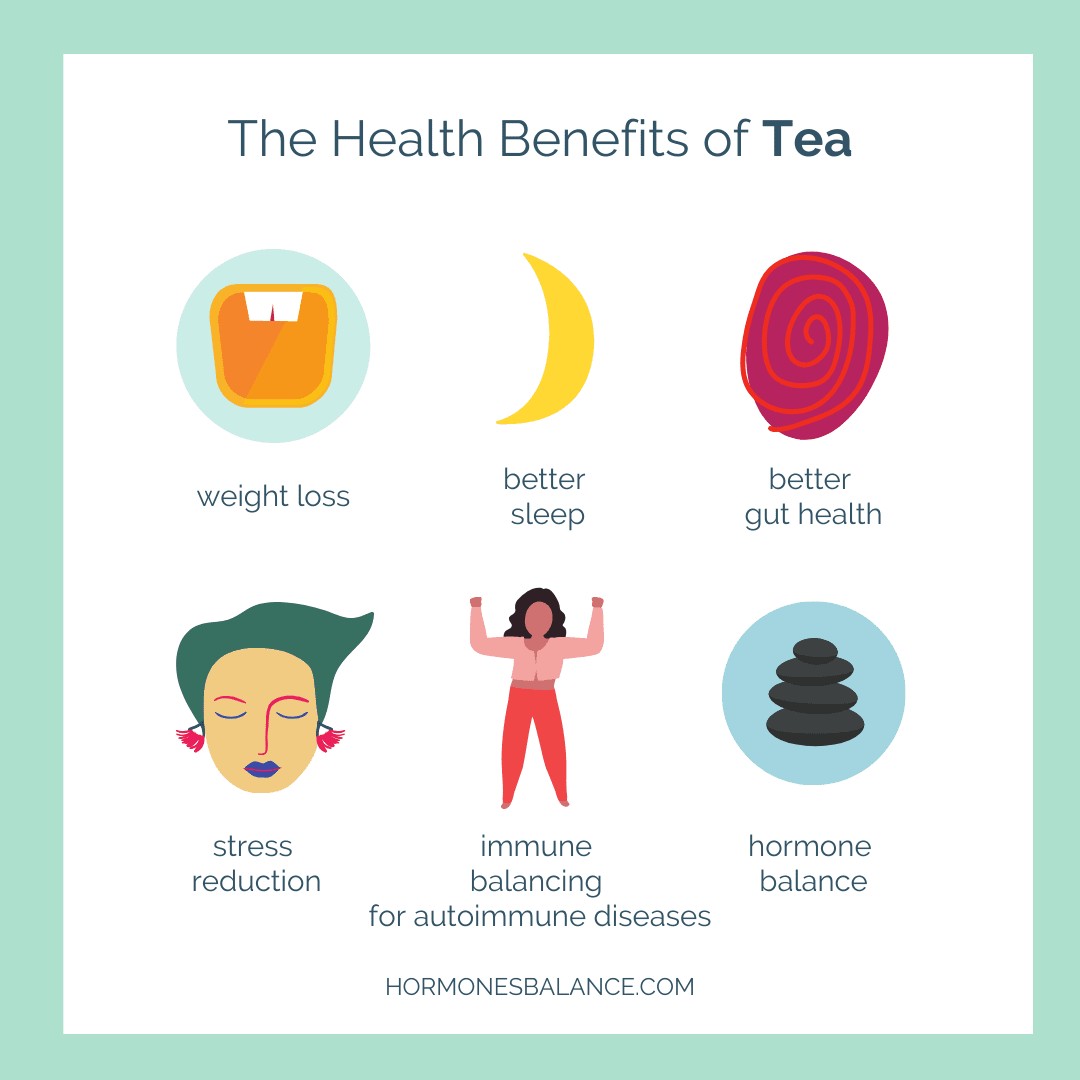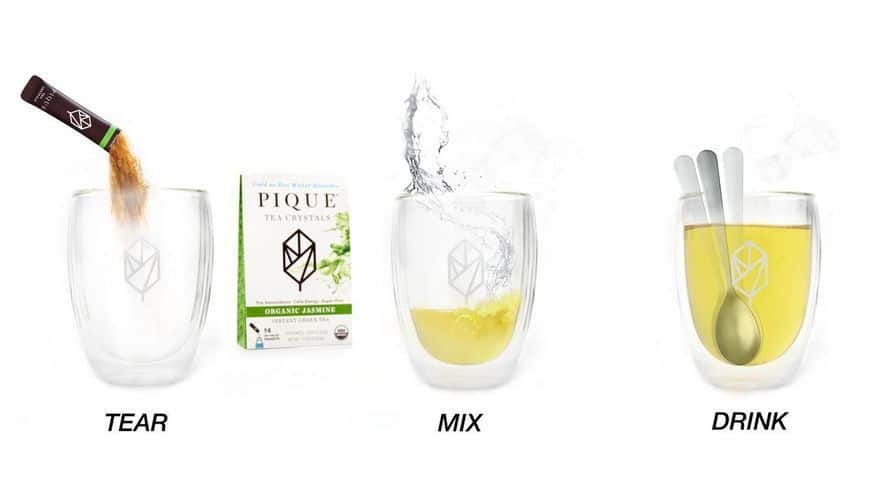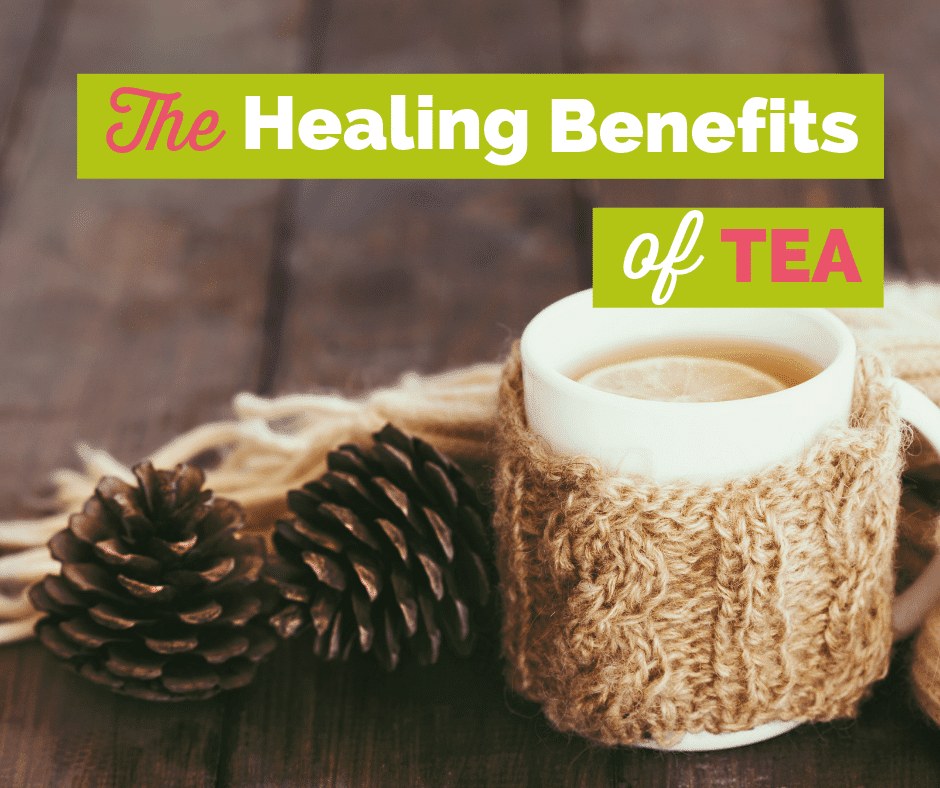What You Will Learn in this Article:
- History of Concentrated Tea/Tea Paste
- Difference Between White, Green, and Black Teas
- Health Benefits of Tea (Camellia Sinensis)
- Weight Loss
- Stress Reduction and Improved Sleep
- Hormone Balance
- Better Gut and Digestive Health
- Immune Balance for Autoimmune Diseases
- Pique Teas: Ingredients and Other Potential Benefits
Tea Crystals from Pique Tea
I receive so many requests to review and try new products – I decline most of them.
However, the Pique Tea founder’s story got me interested – not only did he heal a severe infection by changing and optimizing his health, but he also came up with the idea of “dehydrated tea” from his travels around the Yunnan province in China.
The Yunnan province has a special place in my heart for its natural dramatic beauty, fiery and scrumptious cuisine and kind, cheerful people.
One thing I remember from my trip there was “Cha Gao” which translates to “tea paste.” Tea that is native to Yunnan, Pur-eh tea is brewed for a long time and then dehydrated – to form a gooey paste. It’s the ancient form of “instant tea” – you just pinch a little and add hot water to enjoy an instant cup of hot tea.
This is where the founders of Pique Tea got their inspiration to dehydrate organic teas.
Let me share that I was skeptical at first. I questioned if it had any chemicals (flavors, preservatives or additives) added, how was it dehydrated, where did the tea leaves come from (China has an infamous reputation for excessively spraying their tea plantations), and would they really taste good.
These teas did pass my personal litmus test. I’m therefore sharing them with you.
History of Concentrated Tea/Tea Paste
Leaves from the tea plant, Camellia sinensis, have been brewed to make a health-promoting beverage for thousands of years. The earliest known tea consumption dates back to 2737 BC, according to ancient Chinese legend. As the story goes, the Chinese emperor, Shen-Nung, was boiling water when some leaves from a tea bush accidentally fell in. From that point on, tea became a regular part of the Chinese diet and was considered to be a health tonic.
During the Tang Dynasty (in the 8th century) the native people of the Chinese Yunnan Province, near Tibet, created a concentrated tea paste. Tea-infused water was boiled over and over again until a concentrated paste was formed. This “Cha Gao,” literally “tea paste,” was either consumed straight or dissolved into water to support wellness and vitality.
Difference Between White, Green, and Black Teas
White, green, and black teas are all dried leaves from the tea plant, Camellia sinensis. The difference between the three is whether or not they contain buds, how much they are oxidized, and whether they are allowed to ferment. The processing of the teas impacts the caffeine levels as well as the benefits derived from drinking each type.

White Tea
White tea is made from the young buds and unfurled leaves of the tea plant. At this stage of the plant’s growth, the unopened buds are covered with fine, white hairs; hence the name, “white tea.” After harvesting, the buds and leaves are not allowed to wilt but are immediately steamed to inactivate the enzymes that would otherwise cause the tea to oxidize and turn brown. As a result, the tea retains its light color.
After the steaming, the tea is dried for up to two days, graded (evaluated for quality), and packaged to sell. Because white tea is unoxidized (or semi-oxidized), unfermented, and the least processed, it retains a high level of its antioxidant constituents.
Green Tea
Green tea is made from fresh, unfermented leaves of the tea plant. After being gathered, the leaves are allowed to wither, then either steamed or pan-fired to prevent oxidation or fermentation (so it stays green), then rolled or shaped (for instance gunpowder green tea, which looks like pellets), then finally dried and graded.
Black Tea
Black tea is made by first crushing the wilted tea leaves, allowing them to oxidize by exposing them to air. With oxidation, the leaves turn brown, much like an apple exposed to air. During the oxidation process, the flavor gets stronger and the color, darker. After oxidizing, the tea is allowed to ferment for several hours before steaming, pan firing, or smoke firing the leaves.
The level of oxidation really makes the difference among the different types of teas – in both the look (how dark) and the aroma and taste. Perhaps more importantly for our purposes, the level of oxidation also changes which polyphenols (beneficial plant compounds) you get from drinking each tea.
With less oxidation, as in white tea, there are more catechins – a potent antioxidant.
With more oxidation, as in black tea, there are more theaflavins and thearubigins.
For all the teas, the amount of caffeine in the final beverage is determined by the size of the leaf, the amount of time brewed, and the temperature of the water used.
Health Benefits of Tea (Camellia Sinensis)
Some health benefits particularly relevant to our community include the following:
Weight Loss
White tea has high levels of the antioxidant, Epigallocatechin gallate (EGCG). A study published in the journal, Nutrition & Metabolism, showed that EGCG helps prevent fat from accumulating in the first place. Not only that, but EGCG also helps you break down the fat you’ve got.
The catechins found in green tea especially have been shown to help you lose extra fat – particularly that stubborn abdominal fat. It does this by raising levels of adiponectin, an important weight-regulating hormone that tends to be higher in lean people. Green tea catechins have also been shown to lower your appetite by lowering the “hunger hormone,” ghrelin. Getting these hormones reigned in goes a long way toward overall hormone balance.
Black tea is also helpful in weight loss. It turns out, the polyphenols found in black tea are actually more effective than those found in green tea for weight loss.
These polyphenols work in 3 ways:
1) They reduce your digestion and absorption of fat and carbs
2) They promote the breakdown of stored fats
3) They reduce oxidative stress in the body. When you lower oxidative stress and inflammation in the body, your metabolism works better and it’s easier to lose the extra pounds.
All three teas, white, green, and black, enhance the activity of insulin. In fact, it increases it by over 15 times. This is especially helpful for someone dealing with insulin resistance and the associated weight gain.
Stress Reduction and Improved Sleep
L-theanine is an amino acid that is rarely found in nature, but found in significant amounts (25-60 mg per 200 ml) in tea leaves.
L-theanine has been found to reduce excitatory brain chemicals, increase the calming neurotransmitter, gamma-aminobutyric acid (GABA), and enhance alpha brain waves. Alpha waves occur when you’re in a deep relaxation state.
Low caffeine green tea lowered stress markers and was associated with better quality of sleep in a small study of middle-aged people. The L-theanine contained in the green tea was thought to be the active component, as it converts the stimulating glutamic acid to the calming GABA.

Hormone Balance
Tea polyphenols inhibit aromatase (talked about in this post), and thereby address estrogen dominance. Green tea may also reduce the risk of breast cancer, though more studies are needed.
The EGCG that is highest in white and green teas has also been shown to balance out the stress response by lowering cortisol levels. Getting your cortisol levels evened out is vital for overall hormone balance.
Better Gut and Digestive Health
Food-derived polyphenols from foods like blueberries, pomegranate, and dark chocolate are known to be beneficial for your gut, and polyphenols from tea are no exception. Catechins and flavonoids from tea have been shown to increase beneficial bacteria like the Lactobacillus subspecies and decrease detrimental bacteria like Clostridium and Staphylococcus genera.
Green and black tea can actually act as prebiotics, to feed the good bacteria in your gut. Green tea in this way has been shown to increase the proportion of Bifidobacteria in the colon.

Immune Balancing for Autoimmune Diseases
Animal studies on the EGCG found in green tea show promise for the prevention of autoimmune diseases. The group consuming the EGCG had fewer antibodies to their own tissue and showed less damage over time.
How Can We Capitalize on These Benefits?
It’s all about BOTH quality and quantity. Drinking a cup or two a week is a start, but you won’t reap the benefits of the tea at that level of consumption. The Harvard School of Public Health recommends at least 3 cups of tea per day to reap the health benefits.
Pique Teas: Ingredients and Benefits
If you have followed my work for a while, you know that I’m not a fan of coffee – I wrote about all the reasons here.
Ideally, I would ask you to get off caffeine completely but I also know that many of you just won’t. And, some of you may not find it necessary either; if your adrenal function is healthy, you may be OK with small daily doses of caffeine.
If you are doing caffeine, here are some health-supporting options:
Caffeinated
Jasmine Green Tea simply contains organic jasmine-scented green tea. The scent of jasmine is known to be calming and uplifting.
Caffeine: HIGH (45-55 mg)
Antioxidants: HIGH (273-333 mg)
L-theanine: HIGH (14-17 mg)
Mint Green Tea contains organic green tea and organic spearmint leaf.
Caffeine: LOW (28-34 mg)
Antioxidants: MEDIUM (213-260 mg)
L-theanine: LOW (8-9 mg)
Sencha Japanese Green Tea contains organic green tea of the sencha variety.
Caffeine: MEDIUM (31-37 mg)
Antioxidants: HIGH (223-273 mg)
L-theanine: HIGH (11-14 mg)
Earl Grey Black Tea is organic Ceylon black tea with natural bergamot flavor in the form of bergamot oil.
Caffeine: MEDIUM (32-39 mg)
Antioxidants: HIGH (221-270 mg)
L-theanine: MEDIUM (9-11 mg)
English Breakfast Black Tea is a blend of single estate organic Assam and Ceylon black teas.
Caffeine: HIGH (43-53 mg)
Antioxidants: MED (206-252 mg)
L-theanine: MED (10-12 mg)
Non-caffeinated (elixirs)
Hibiscus Beauty Elixir is made up of organic Egyptian hibiscus, organic mint, and organic stevia leaf.
Rooibos Immunity Elixir is simply organic Rooibos and Madagascar vanilla. Rooibos, literally “red bush” tea, is not actually tea, as it does not come from the tea plant. Rooibos comes from a South African shrub, Aspalathus linearis.
Ginger Digestion Elixir contains organic ginger root, organic orange peel, organic lemon peel, organic mint leaf, and organic licorice root.

How Pique Tea is Made – The Technique
Pique tea uses a technique called Cold Brew CrystallizationTM to make their tea crystals. This process can take up to 8 hours per batch. Just like making cold brew coffee, cold brew crystallization uses cold water to create the infusion.
Antioxidants can be damaged by heat, so the cold brew process helps to preserve as many antioxidants as possible. In fact, third-party testing has confirmed that Pique teas have up to 12 times the polyphenols of other comparable teas.
After the tea has been brewed and all the phytonutrients extracted, the water is slowly removed using low-temperature dehydration and pressure. What’s left is a super potent tea concentrate in the form of crystals.
Purity: Organic and Toxicity Reports
The purity of teas has become a major concern in recent years. Research published in the journal, Toxicology, found that all the teas sampled in the study contained lead. When brewed for 3 minutes, 73% of them had lead levels that would be considered hazardous during pregnancy and breastfeeding. When brewed for 15 minutes, 83% would be considered toxic and dangerous to pregnant and nursing mothers.
Additionally, an investigation conducted by the Canadian Broadcasting Corporation (CBC) found that many of the world’s top tea brands contained illegally high levels of pesticide residues. Out of the 10 teas tested, half of them had residues over the legal limit. Not only that, but eight of them contained not just one, but multiple chemicals hidden in the tea leaves. One brand even had residues of 22 different pesticides. Among these chemicals were endosulfan and monocrotophos, two pesticides that are so dangerous that many countries are attempting to ban them from use.
Pique teas are triple toxin screened for pesticides, mold, and heavy metals such as lead and mercury. They have been analyzed by the Fresenius Institute in Germany, a top lab analysis company that’s been in the business for over 150 years. The results confirm that Pique teas are extremely clean and not only meet but surpass organic standards.
I’m attaching some of the labs here and here.
Tea Demo
Here is a quick video showing you how easy it is to make these teas and which ones are my favorites.
Pique Tea Offer for Hormones & Balance Readers
If you want to try Pique tea, this is the time to do it.
They have a number of offerings. Browse their full selection here.
For a meditative experience, check out Pique Tea’s Reishi Calm Elixir. I personally love their fermented Pu’er tea offerings, too.
Please note that this is a sponsored post, meaning I do receive a small percentage of sales, but all opinions are my own.
Resources:
https://www.ncbi.nlm.nih.gov/pmc/articles/PMC4055352/
https://www.ncbi.nlm.nih.gov/pmc/articles/PMC4466773/
https://www.hindawi.com/journals/jt/2013/370460/
http://www.teausa.com/14655/tea-fact-sheet
https://www.ncbi.nlm.nih.gov/pmc/articles/PMC3220617/
https://www.sciencedirect.com/science/article/pii/S0367326X10000171
https://www.ncbi.nlm.nih.gov/pubmed/25824404
https://hormonesbalance.com/articles/key-herbs-vitamins-and-supplements-to-restore-your-adrenal-deficiency/
https://www.ncbi.nlm.nih.gov/pmc/articles/PMC3498851/
https://www.ncbi.nlm.nih.gov/pmc/articles/PMC3459493/
https://theteaspot.com/steep-it-loose/tea-health/how-tea-processing-affects-antioxidants-and-health/
https://www.ncbi.nlm.nih.gov/pubmed/19008868
https://www.ncbi.nlm.nih.gov/pubmed/26093535
https://www.ncbi.nlm.nih.gov/pubmed/27941615
https://www.ncbi.nlm.nih.gov/pmc/articles/PMC2952901/
https://www.cbc.ca/news/canada/pesticide-traces-in-some-tea-exceed-allowable-limits-1.2564624
https://www.ncbi.nlm.nih.gov/pmc/articles/PMC2848451/
https://www.ncbi.nlm.nih.gov/pmc/articles/PMC3880318/
https://www.sciencedaily.com/releases/2007/04/070419140910.htm
https://www.ncbi.nlm.nih.gov/pmc/articles/PMC5537891/
https://www.ncbi.nlm.nih.gov/pubmed/12428980
https://www.ncbi.nlm.nih.gov/pubmed/18296328
https://www.researchgate.net/publication/249317405_Benefits_of_polyphenols_on_gut_microbiota_and_implications_in_human_health
https://www.ncbi.nlm.nih.gov/pubmed/22924537
https://www.ncbi.nlm.nih.gov/pmc/articles/PMC5788221/
https://www.ncbi.nlm.nih.gov/pubmed/19585478
https://www.piquetea.com/collections/all/products/organic-hibiscus-beauty-elixir
https://www.ncbi.nlm.nih.gov/pubmed/22721439
https://www.ncbi.nlm.nih.gov/pubmed/24549255
https://www.ncbi.nlm.nih.gov/pubmed/19083477
https://www.ncbi.nlm.nih.gov/pubmed/26151031
https://www.ncbi.nlm.nih.gov/pmc/articles/PMC3897768/
https://www.ncbi.nlm.nih.gov/pubmed/10442508
https://www.ncbi.nlm.nih.gov/pubmed/29193411
https://edis.ifas.ufl.edu/fs285
https://www.ncbi.nlm.nih.gov/pubmed/16872313
https://www.hsph.harvard.edu/nutritionsource/healthy-drinks/other-healthy-beverage-options/

You mention white peony and oolong (I think), but I don’t see those on the company’s website. Where did you find those? Thanks.
I may have misheard in the video as you don’t mention these in the write-up. So, disregard if I did. Thanks
HI Luann, I looked too and they did not have those right now, I believe they are coming soon. ~ jennifer HB Support
Magdalena, do you think that we should be concerned about the fluoride in tea? I hear such conflicting information but have heard fluoride is an iodine uptake inhibitor and so really not good for anyone, but especially for anyone with Hashimotos. I’ve also heard that fluoride builds up in your body and it takes a long time to get rid of it. Is this something we should be concerned about?
I LOVE tea, would love to have it a part of my routine, and want all the benefits that you are listing. I would be so interested in your opinion on this. Thank you.
HI Judy, we are not familiar with fluoride in tea. We are familiar with it in water, so you would want to use a good water filter to filter that out, as fluoride is a neurotoxin. ~ Jennifer HB Support
Jennifer, sadly, there is fluoride in tea.
These teas sound amazing but unfortunately they do not offer the non-caffeinated varieties you mention in the video online as part of the bundle deals. I cannot do caffeine right now due to adrenals. Too bad the offer isn’t good for folks like me. Thanks
Hi Jessica,
We will keep an eye out if they change what is offered in their bundle. Thank you for this suggestion. We appreciate your feedback. ~Deanna HB Team
[…] While not everybody may not be affected by coffee, I still recommend drinking a high quality tea. In this article on tea you can read all about the benefits that tea […]
[…] Green tea (I love Pique tea) […]
[…] of fermented tea, I highly recommend the brand Pique, which I’ve also talked about in articles here and […]
I’ve been using green tea almost 5 years for me so amazing results works good and the best results within me is i look 10 years younger tuan my age. As every one said to me. I never used any cosmetics to my face due to the reason i have sensitive skin. When i found out the benifits in green tea, i tried it and it reallyworks ’til these time. My employers asked me why i drunk more green tea everyday. I answered them that this is my life. Lately, my cousin in Germany called me 3 weeks ago and advice me to try with Pique tea. But then ,i wasnt able to go out since pandemic outbreaks spreading here in Cyprus.
Avery interesting and informative article. How does teas help with hormone balancing ?
.
[…] of my favorite tea companies, Pique Tea, makes two mushroom elixirs: Chaga Energy Elixir for daytime and Reishi Calm Elixir for […]
I’ve been following your blog since long.
Your recent post really resonated with me. I thought it was something my audience would appreciate, so I shared it with my social media and email subscribers.
India tea also, known as Masala Chai .The tea leaves are boiled along with additions and then boiled again after the addition of milk and sugar.
TeaSwan Offers High Quality And Purest Flavors Of Teas. Our Each Tea Purchase Comes With Organically And Ethically Grown Teas, Carefully Blended To Create The Perfect Cup.
Kangra Tea of India is one of the finest orthodox teas because of its unique aroma & flavour. Ours is the Certified Organic orthodox black & green tea sold in the name of Dhauladhar Him Palam Tea.